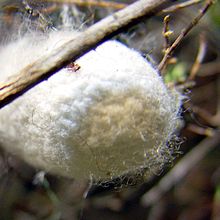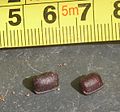cocoon

A cocoon [ koˈkɔ̃ː; -ˈKɔŋ; -ˈKoːn ] ( French : cóque = eggshell, housing) is a housing made with a secretion that serves to protect the eggs or juvenile forms of the animals who built it. When a cocoon is produced to protect the eggs and the hatchling offspring, the parent animals make it. Cocoons, which are necessary to survive older stages of development, such as the rest of the pupae , are made by the young animals inside. Cocoons can be found mainly in various arthropods , but also in some worms .
Cocoons in arthropods

Cocoons can occur within the arthropods, for example, in insects , arachnids and double pods. In holometabolic insects , in addition to those used to protect the eggs, there are also those that help the pupa to survive until the imago hatches. The best known are those of the caterpillars of certain Butterfly - Family cocoons produced. Butterfly caterpillars produce this by means of a liquid exiting from the spinneret, which quickly solidifies into threads in the air. These are spun into a cocoon, in which the caterpillar sheds its skin to form the pupa , in order to then spend the entire rest of the pupa in it. The cocoons of the silkworms provide the silk . The beetle larvae ( grubs ) of the superfamily Scarabaeoidea also make a cocoon from body secretion and earth for the pupae to rest, which they only leave as adult beetles. Like the cavity in which beetle larvae pupate in burrows, it is called the pupa cradle .
Cocoons, which are made to protect the eggs, often have species-specific shapes and are usually referred to as ootheca . Cockroaches (Blattodea), and Mantis (Mantodea) produce their cocoons called oothecae by lay their eggs in a signal output from the females during the egg-laying, solid curing secretion. The cocoons that some beetles make for their eggs, on the other hand, are not called oothecae. The females of many water beetles (Hydrophilidae) have a spinning apparatus at the end of their abdomen with which they spin a cocoon for their eggs. This can be attached to aquatic plants or float freely in the water as a so-called boat. With most arachnids (Arachnida) the eggs are cocooned in cocoons.
Some groups of the bipedes (Diplopoda) produce cocoons for their eggs, which are often referred to as ooths, like those of the muzzle and cockroaches. The production of the cocoons of cordefoots (Julida) and ribbon pods (Polydesmida) is similar to that of the doll's cradle of the Scarabaeoidea. They line the caves in which they have laid their eggs with a secretion that hardens their walls. The cocoons of the seed pods (Chordeumatidae) are created by spinning the eggs into a web.
Cocoons in worms
To protect the eggs and later the young worms, some worms also produce cocoons. In belt worms (Clitellata) a mucus secretion to the belt (Clittellum) which is fixed relative soon. The girdle worms pull themselves out backwards from the short tube created in this way. When the sex pores pass through, the eggs are then pressed in. With the few bristles (Oligochaeta), fertilization takes place while passing through the seed pocket (Receptaculum seminis). The sperm contained in it are also released into this tube, where they fertilize the eggs. Other forms of fertilization also occur in the leeches (Hirudinea). When the worm pulls its head out of the tube, its two openings close. The result is an often thin-skinned cocoon, sometimes with a thick or foam-like wall, with a protein-rich nutrient solution. In this, the eggs develop into young worms, which finally hatch.
photos
Wasp spider cocoon ( Argiope bruennichi )
Oothecae the American cockroach ( Periplaneta americana )
See also
Web links
Individual evidence
- ^ Erwin Hentschel, Günther Wagner: Zoological Dictionary , Gustav Fischer Verlag Jena, 4th edition 1990, p. 296 ISBN 3-334-00348-5
- ^ Kurt Günther, Hans-Joachim Hannemann, Fritz Hieke, Eberhard Königsmann & Hubert Schuman: Urania animal kingdom - insects. Urania-Verlag, Leipzig, Jena 1989, p. 258, ISBN 3-332-00255-4
- ↑ www.diplopoda.de - For the egg-laying of the diplopods
- ↑ Horst Füller, Hans-Eckhard Gruner, Gerhard Hartwich, Rudolf Kilias & Manfred Moritz: Urania Tierreich - Invertebrates 2. Urania-Verlag, Leipzig, Jena 1994, pp. 70 & 88, ISBN 3-332-00502-2


